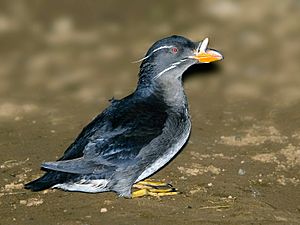Rhinoceros auklet facts for kids
Quick facts for kids Rhinoceros auklet |
|
|---|---|
 |
|
| Adult, Japan | |
| Conservation status | |
| Scientific classification | |
| Genus: |
Cerorhinca
|
| Species: |
monocerata
|
 |
|
The rhinoceros auklet (Cerorhinca monocerata) is a cool seabird. It is a close relative of the puffins. Some people even call it the rhinoceros puffin because they are so similar! It is the only living species in its group, Cerorhinca.
This bird lives across the North Pacific Ocean. It eats small fish and builds its nests in large groups called colonies. Its name comes from a special horn on its beak. This horn is only on adult birds during breeding season. Like the colorful beak of puffins, this horn falls off every year. The horn can also glow under ultraviolet light. Scientists think this glow helps the birds find mates.
The rhinoceros auklet is a medium-sized auk. It has a big, strong, orange-brown beak with the horn sticking out. Its feathers are dark on top and lighter underneath. During breeding season, both male and female adults have white feathers above their eyes and behind their beak. Male auklets are a little bigger than females.
Contents
Where Do Rhinoceros Auklets Live?
The rhinoceros auklet lives in the North Pacific. They breed from California in the Channel Islands all the way to the Aleutian Islands in Alaska. In Asia, they live in Hokkaidō and Honshū, Japan. They also live near the Korean Peninsula and Sakhalin Island.
In winter, they live in waters both far from shore and closer to land. Many of them travel, or migrate, between October and April. A lot of auklets from breeding colonies north of California move to the waters off California. However, some auklets that already live off the California coast stay in their home areas.
Life Cycle and Reproduction
Rhinoceros auklets breed in early summer, usually from May to June. They dig burrows in the soil for their nests. They also use natural caves or holes that are about 1 to 5 meters deep. They like to nest on slight slopes. This helps them take off, as they are not very good at flying.
Both parents take turns sitting on a single egg for 30 to 35 days. After the chick hatches, it is fed every night. The parents bring a beak full of fish, just like puffins do. This feeding goes on for 35 to 45 days. They feed their chicks at night to avoid predators like gulls. It also helps them avoid gulls stealing their food.
Rhinoceros auklets stay with the same partner for life. Even though they travel to similar areas in winter, they migrate separately. But when they return to their colony before laying eggs, they start looking for food together.
What Do Rhinoceros Auklets Eat?
At sea, rhinoceros auklets mainly eat fish. They also eat some krill and squid. During the breeding season, they hunt for food closer to shore in the middle of the water. To catch their prey, they can dive very deep. They can go as deep as 57 meters (187 feet) and stay underwater for up to 148 seconds!
Scientists have studied what nesting rhinoceros auklets eat. Their diet changes depending on where their nest is. For example, at one island near the Salish Sea off Washington, they mostly eat sand lance. But at another island also off Washington, they eat anchovy and smelt.
Why Does the Bill Glow?
Rhinoceros auklets are very social birds and stay with one partner for life. This means they rely on how their partner looks to choose them. The horn on the beak of breeding auklets is important for this. What's even more interesting is that their bill glows when seen under ultraviolet light!
Many bird species can see UV light. This suggests that the glowing bill is also used for breeding. The horn glows the most, but the upper and lower parts of the beak also glow. Scientists have not found any difference in how much males and females glow. However, the amount of glow can be different between individual birds.
See also
 In Spanish: Alca unicórnea para niños
In Spanish: Alca unicórnea para niños


